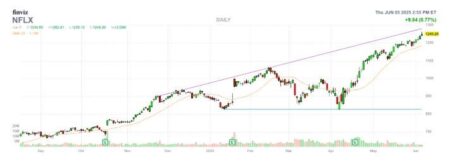In the past two years, artificial intelligence technology has dominated market discussions, primarily concerning big-tech stocks and semiconductor companies. However, two major data stocks are making significant investments in the AI revolution. Palantir and Snowflake (NYSE: SNOW) are both rapid-growth software firms. Over the last twelve months, Palantir’s stock has demonstrated impressive performance with an increase of more than 500%, whereas Snowflake has experienced a rise of approximately 52% during the same time frame. Importantly, the two companies differ notably in their approaches. Palantir centers on specialized big data analytics for mission-critical applications in government and commercial sectors, while Snowflake offers cloud data warehousing services to a more varied customer base. Here’s why we believe Snowflake may currently represent a superior investment compared to Palantir, based on an evaluation of Growth, Profitability, Financial Stability, and Downturn Resilience.
Snowflake’s Growth is Slowing, While Palantir’s is Gaining Momentum
In terms of growth, Snowflake has delivered faster revenue expansion over the last few years, achieving a 3-year average growth rate of 44.8% compared to Palantir’s 23.9%. Even when looking at the most recent trailing 12 months, Snowflake’s revenue increased by 29.2% to $3.6 billion, whereas Palantir’s rose by 33.5% to $2.9 billion. However, Palantir’s growth has been gaining traction recently. In the latest quarter, Palantir’s sales surged by 39.3%, surpassing Snowflake’s 27.4%. Although both companies are experiencing rapid growth, Palantir’s recent acceleration can be attributed to key government contract wins and progress within its commercial sector, while Snowflake’s growth has decelerated due to rising competition from companies like Databricks and a gradually maturing cloud market. Nonetheless, Snowflake’s early advantage in data warehousing accounts for some of its historical growth edge.
Profitability and Cash Flows
Regarding profitability, the disparity is even more pronounced. Over the last four quarters, Palantir Technologies’ Net Income reached $571 million, reflecting a robust net income margin of 18.3% (compared to 11.6% for the S&P 500). During this timeframe, Palantir Technologies’ Operating Cash Flow (OCF) was $1.3 billion, indicating a significantly high OCF margin of 42.8% (versus 14.9% for the S&P 500). In contrast, Snowflake’s metrics are considerably poorer. For the same period, Snowflake’s Net Income was -$1.3 billion—indicating a severely negative net income margin of -35.5% (compared to 11.6% for the S&P 500). This situation is partly due to Snowflake granting significant stock-based compensation. However, it remains a point of concern, as stock-based compensation increases the outstanding share count, diluting current shareholders. For the same period, Snowflake’s Operating Cash Flow (OCF) totaled $960 million, resulting in a moderate OCF margin of 26.5%.
No Balance Sheet Challenges Here
From a financial stability point of view, both companies exhibit robust balance sheets, though Palantir has a slight advantage. At the close of the most recent quarter, Palantir Technologies’ debt stood at $245 million, while its market capitalization is $310 billion (as of 6/3/2025). This results in a notably low Debt-to-Equity Ratio of 0.1% (compared to 19.9% for the S&P 500). Cash (including cash equivalents) comprises $5.4 billion of the total $6.7 billion in assets, yielding a strong Cash-to-Assets Ratio of 80.6% (compared to 13.8% for the S&P 500). On the other hand, Snowflake’s debt was $2.7 billion, with a market cap of $70 billion, indicating a Debt-to-Equity Ratio of 3.9%—still quite healthy, though somewhat higher than Palantir’s. Cash accounts for $4.6 billion of Snowflake’s $9.0 billion in total assets, resulting in a Cash-to-Assets Ratio of 51.3%. These figures suggest that both companies are well-equipped to handle liquidity challenges, although Palantir’s leaner balance sheet and larger cash buffer are noteworthy.
Downturn Resilience
Ultimately, market downturn resilience is a concern for both companies. Palantir’s stock plummeted over 84% during the inflation crisis of 2022 but has since completely rebounded and achieved new highs. Snowflake’s shares fell almost 72% during the same downturn and have not yet returned to their previous peak, reflecting ongoing investor hesitance. Both firms exhibit extreme volatility in bear markets, but Palantir’s recovery has been more substantial, possibly due to its improving profitability and operational metrics. In the end, both stocks remain highly sensitive to broader economic conditions and investor mood.
Not thrilled about the unpredictable nature of PLTR and SNOW stocks? The Trefis High Quality (HQ) Portfolio, which encompasses 30 stocks, boasts a history of significantly outperforming the S&P 500 over the last 4 years. What’s the secret? Collectively, HQ Portfolio stocks have delivered superior returns with less risk relative to the benchmark index; it offers a smoother experience as highlighted by HQ Portfolio performance metrics.
The Major Concern: Valuation
Valuation serves as a significant differentiator between the two stocks. Palantir’s stock trades at exceedingly high valuation multiples, featuring a price-to-sales (P/S) ratio of 93.4 and a price-to-free cash flow (P/FCF) ratio of 218. In comparison, Snowflake exhibits a still-elevated P/S of 18.9 and a P/FCF of 71.3. Certainly, Palantir’s growth rates are improving relative to Snowflake, which is experiencing a slowdown in growth. Furthermore, the founders of Palantir hold substantial sway within the Trump Administration, and anticipated increases in federal expenditures on national security and immigration under Trump could lead to heightened demand for Palantir’s software. Nevertheless, there’s a compelling argument for Snowflake as well. Clients depend on Snowflake for data storage and management through its cloud platform. This access may result in greater adoption of Snowflake’s AI tools. For example, customers can increasingly utilize natural language prompts to query and access their data. As the cost of running AI models declines, customers may become more inclined to leverage generative AI tools for a broader range of applications, thereby boosting demand for Snowflake’s data storage and processing offerings. While Snowflake’s lower profitability and reduced growth in the recent past raise concerns, we believe the risk-reward profile might be more advantageous for Snowflake stock, positioning it as the more favorable choice.
Read the full article here
















